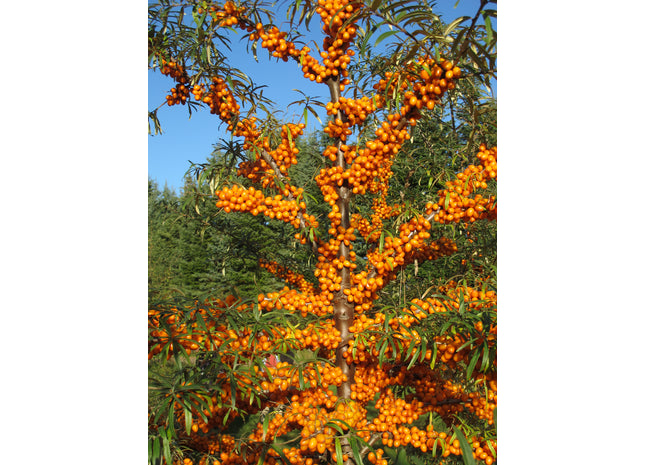Berries - Acorn

AgroForestry Solutions Saskatoon Berry Seed
Latin Name: Amelanchier alnifolia DESCRIPTION Family: Rosaceae Native Range: Native to the Canadian prairies. Seed Source: Nortlhline Saskatoon berry orchard growing near Leroy Saskatchewan. Height and Spread: 3m x 2m (5 years) Overview: This saskatoon berry seed strain is a bountiful berry producer. These bushes have been an excellent source of berries since the 1950’s. It is characterized by reliable berry production of flavourful medium-sized berries. This strain is adapted to a wide range of growing conditions. Fruit: Berry-like pomes up to 1.0 cm in diameter containing a single seed. Average number of seeds/packet: 600 SEED TREATMENT / SOWING Stratification: Pre-soak seed for 24 hours then stratify in moist sand (10% moisture) for 90-120 days at 5°C. Ideal sowing time: Non-pretreated seed outdoors in late September (will germinate the following spring) or stratified seed in spring. Sowing instructions: Outdoors - sow 1.0 to 1.5 cm deep, 50 seeds/meter; Greenhouse - sow 3 seeds per cell. Growing conditions: Saskatoon berry grows on a wide variety of soils but favors moist, loamy soils with a pH of 5.0 to 8.0. It is shade tolerant but prefers a sunny exposure. AGROFORESTRY VALUE Saskatoon berry is used in shelterbelts, Ecobuffers, and wildlife habitat plantings. The dense roots and rhizomes of Saskatoon make it useful for soil stabilization and erosion control on moist sites including streambanks. It provides good food and cover for birds plus small and large mammals. The berries are highly edible and are a prized fruit-producing plant in the home garden or commercial orchard.
$30.00

AgroForestry Solutions 'Indian-Summer' Seabuckthorn Seed
Latin Name: Hippophae rhamnoides ssp. Mongolica DESCRIPTION Family: Elaeagnaceae Native Range: Europe and Asia Seed Source: Seed production orchard near Indian Head, Saskatchewan. Height and Spread: 4m x 2m (10 years) Overview: A wonderful plant recognized by many as one of the most nutritional berries in the plant kingdom. A nitrogen fixer, the 'Indian -Summer' seed strain is extremely hardy and adapted to low quality, droughty soils. Seeds produce a mixture of male and female plants. Fruits: An orange drupe-like achene 3 to 6mm long. Berries remain on shrubs over winter. Average number of seeds/packet: 240 SEED TREATMENT / SOWING Stratification: Soak the seeds for 24 hours, then stratify in moist sand (10 percent moisture) for 60 days at 5C. No treatment needed if down outdoors in late September (Germination occurs the following spring). Ideal sowing time: Spring Sowing instructions: Outdoors - sow 1 cm deep and 50 seeds/meter; Greenhouse- sow 3 seeds per cell. Growing conditions: 'Indian-Summer' grows well on a variety of soils, requires full sunlight, does not tolerate shade. AGROFORESTRY VALUE 'Indian-Summer' is an excellent seed strain for farm or field shelterbelts, intercropping, reclamation, and wildlife habitat plantings. The seed strain was developed specifically for agroforestry, stabilizes eroding soil, contributes nitrogen, and provides wildlife valuable cover. It is often used as a pollinator row in seabuckthorn orchards. One of the most versatile agroforestry plants. Harvest Seabuckthorn berries Your browser does not support our video Your browser does not support our video
$25.00

AgroForestry Solutions 'Ralph Dunlop' Silver Buffaloberry Seed
Latin Name: Shepherdia argentea DESCRIPTION Family: Elaeagnaceae Native Range: Canadian Prairie Provinces, United States Northern Great Plains. Seed Source: Natural stand near Indian Head Saskatchewan. Height and Spread: 4m x 2m (10 years). Overview: The 'Ralph Dunlop' seed strain was developed for tree planting in the Canadian prairies. This strain originates from a natural stand of buffaloberry with above average berry size. The strain is named in honour of Ralph Dunlop a tree planting technician at the Indian Head Forest Nursery Station from 1924 to 1961. Buffaloberry is a wonderful plant recognized by many as one of the most nutritional berries in the plant kingdom. Seeds produce a mix of male and female plants. Fruits: A red drupe-like achene 3 to 6mm long. Average number of seeds/packet: 750 SEED TREATMENT / SOWING Stratification: Stratify in moist sand (10% moisture) for 90 days at 5°C. Ideal sowing time: Non-pretreated seed outdoors in late September, Stratified seed in spring Sowing instructions: Outdoors - Sow 1 cm deep and 50 seeds/meter; Greenhouse - sow 3 seeds per cell 1 cm deep. Growing conditions: The seed strain requires full sunlight and does not tolerate shade. It is a nitrogen fixer, extremely hardy, and adapted to low-quality, dry soils. Excellent for the farmstead, intercropping, reclamation, Eco-Buffers, and wildlife habitat plantings. AGROFORESTRY VALUE 'Ralph Dunlop' Buffaloberry is an excellent choice for farmsteads, intercropping, reclamation, and wildlife habitat plantings. This seed strain was bred and developed specifically for temperate agroforestry. Buffaloberry stabilizes eroding soil, contributes nitrogen, and provides wildlife valuable cover, particularly upland game birds. Female plants can be used for fruit production. Your browser does not support our video
$35.00



